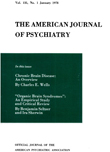Review of behavioral psychotherapy, I: Obsessive-compulsive disorders
Abstract
Obsessive-compulsive ritualizers have maintained their improvement after exposure in vivo for up to 3 years' follow-up in the United States, Britain, Greece, and Australia. Unlike exposure in vivo, relaxation is of little value. Early gains in treatment predict long- term outcome. Exposure therapy is usually on an outpatient basis and takes 1-30 sessions. Self-exposure homework is critical. Sessions at home are also required, together with relatives cooperating as exposure cotherapists. Some patients can treat themselves almost unaided, while others need extensive assistance. Clomipramine is helpful for ritualizers with coexisting depression, but depression tends to recur when clomipramine therapy is stopped.
Access content
To read the fulltext, please use one of the options below to sign in or purchase access.- Personal login
- Institutional Login
- Sign in via OpenAthens
- Register for access
-
Please login/register if you wish to pair your device and check access availability.
Not a subscriber?
PsychiatryOnline subscription options offer access to the DSM-5 library, books, journals, CME, and patient resources. This all-in-one virtual library provides psychiatrists and mental health professionals with key resources for diagnosis, treatment, research, and professional development.
Need more help? PsychiatryOnline Customer Service may be reached by emailing [email protected] or by calling 800-368-5777 (in the U.S.) or 703-907-7322 (outside the U.S.).



